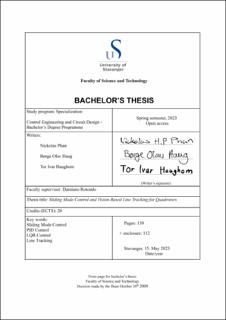| dc.contributor.advisor | Damiano Rotondo | |
| dc.contributor.advisor | Didrik Efjestad Fjereide | |
| dc.contributor.author | Phan, Nickolas | |
| dc.contributor.author | Haug, Børge Olav | |
| dc.contributor.author | Haughom, Tor Ivar | |
| dc.date.accessioned | 2023-06-27T15:51:48Z | |
| dc.date.available | 2023-06-27T15:51:48Z | |
| dc.date.issued | 2023 | |
| dc.identifier | no.uis:inspera:130506351:64304804 | |
| dc.identifier.uri | https://hdl.handle.net/11250/3073587 | |
| dc.description.abstract | This thesis describes the design of Sliding Mode Control applied to quadrotor UAV flight. This is a nonlinear control technique in which a discontinuous control signal is applied to drive the so-called sliding variable to zero, which defines the sliding surface. The sliding variable should be designed in such a way that approaching the sliding surface is beneficial to tracking the reference signals. The advantages of Sliding Mode Control are that the need for simplifying the underlying dynamical model through linearization is avoided, it is robust and adaptive, and works even if the system to be controlled is highly nonlinear or has model uncertainties. Sliding Mode Control has one major issue associated with it, namely the chattering phenomena in the control inputs, which is undesirable. This can be tackled by approximating the discontinuous sign function in the control input with a approximated continuous function, or by applying techniques such as adaptive fuzzy gain scheduling. As with other control methods, Sliding Mode Control requires tuning of the control parameters to obtain an optimal performance. In this work, genetic algorithms were investigated as a way to tune the controller parameters. The findings of this thesis were combined with the design of a line tracking algorithm in order to enter the MathWorks Minidrone Competition. | |
| dc.description.abstract | This thesis describes the design of Sliding Mode Control applied to quadrotor UAV flight. This is a nonlinear control technique in which a discontinuous control signal is applied to drive the so-called sliding variable to zero, which defines the sliding surface. The sliding variable should be designed in such a way that approaching the sliding surface is beneficial to tracking the reference signals. The advantages of Sliding Mode Control are that the need for simplifying the underlying dynamical model through linearization is avoided, it is robust and adaptive, and works even if the system to be controlled is highly nonlinear or has model uncertainties. Sliding Mode Control has one major issue associated with it, namely the chattering phenomena in the control inputs, which is undesirable. This can be tackled by approximating the discontinuous sign function in the control input with a approximated continuous function, or by applying techniques such as adaptive fuzzy gain scheduling. As with other control methods, Sliding Mode Control requires tuning of the control parameters to obtain an optimal performance. In this work, genetic algorithms were investigated as a way to tune the controller parameters. The findings of this thesis were combined with the design of a line tracking algorithm in order to enter the MathWorks Minidrone Competition. | |
| dc.language | eng | |
| dc.publisher | uis | |
| dc.title | Sliding Mode Control and Vision-Based Line Tracking for Quadrotors | |
| dc.type | Bachelor thesis | |
